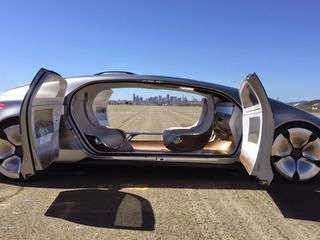This transformation leaves it open to the same vulnerabilities as our consumer devices including hackers and viruses. Overcoming these obstacles will be critical to the success of connected vehicles. The industry is gearing itself up for the age of the 'connected car'. How will this manifest itself and how can such smart cars be protected from threats?
Five Years from Now
By 2020, the connected car will be an everyday reality, enabling new possibilities for drivers. You will be able to drop your car off at the garage for a service and monitor its progress from the office, hand over control to the car in a traffic jam or benefit from next generation connected infotainment services.
We will see the roll out of Vehicle-to-Vehicle (V2V) and Vehicle-to-Infrastructure (V2I) Communication networks, which transform the car into an intelligent transport system capable of communicating with its environment. Together with Delphi, NXP has developed a platform that allows alerts to be delivered to vehicles from other cars and surrounding infrastructure to warn drivers of hazardous traffic situations. This platform could be seen on the road in as little as two years' time.
The success of V2V and V2I will largely depend on manufacturers' ability to convince consumers and governments that the technology is safe. Open networks are ripe targets for abuse from hackers. False messages and signals sent to cars or traffic lights could cause havoc. It's therefore vital that the right levels of authentication and approval are put in place. These security measures do not need to be created from scratch. By introducing existing 'banking level' security to the car at a chip level, similar to what we see today in ATM cards, digital IDs and passports, malicious elements can be blocked and vital systems protected.
Ten Years from Now
Car sharing fleets like ZipCar will be much more common by 2025. Users will be able to book a car on their smart phone and then use Near-field-communication (NFC) to access it. NFC will also be used to personalize car settings: your favorite radio station, preferred temperature and seat position will all be stored on your mobile device and adjust instantly when putting your phone to a sensor pad on the car. While these concepts might sound futuristic all the required technology already exists. In Germany, smart licences have been introduced and can be used to access Car2Go vehicles.
NXP is the co-inventor and number one supplier of NFC and recently unveiled a complete automotive qualified NFC portfolio with world's first NCI-based NFC controller for secure car connectivity. The revolutionary product family means auto manufacturers can not only provide immediate benefits to end users, but can also embrace the innovations of the future.
Data protection will be of paramount importance, as car-sharing companies will need to hold a lot of personal data to allow the user to access, personalize and activate the car. To ensure these details are kept safe from threats we need to take the lessons learned from other areas of enterprise and cloud security and apply them directly to the car.
Twenty Years from Now
Twenty years from now, interaction between drivers and their cars will change completely. Younger generations will have grown up with totally different in-car technology and will view the car not as something to be driven, but as something to drive with. Voice recognition systems will be used by everyone and the smart car will act as a co-driver or even driver.
By this stage cars will probably be more intelligent than the driver when it comes to the environment around them. They will know how best to avoid traffic jams, which routes to take and will be able to respond to hazards far more quickly and effectively than the average driver. Many may prefer the car to do all the driving. This will reduce accidents caused by human error and will hugely increase mobility for the elderly and disabled.
In order for self-driving to become a reality, legislation will also form a core element of ensuring consistent security. Both consumers and governments need to be convinced. Various industry groups, such as the Car 2 Car Consortium, are already collaborating to put these standards in place.
Once the hurdles surrounding security and legislation have been overcome, which I am confident they will be, the future of the connected car looks very promising indeed.





No comments:
Post a Comment
Disclaimer:
Drop Comments
*Comments on this blog are NOT posted by ANY STAFF OF ENEKEM.
*ENEKEM Readers are SOLELY responsible for the comments they post on Enekem.com
*cheers*